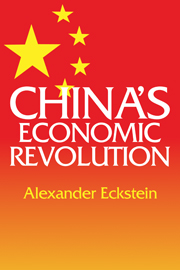Book contents
- Frontmatter
- Contents
- List of tables
- Preface
- 1 The economic heritage
- 2 Development strategies and policies in contemporary China
- 3 Property relations and patterns of economic organization in China
- 4 The resource-allocating system
- 5 The quest for economic stability
- 6 Economic development and structural change
- 7 The role of foreign trade in China's economic development
- 8 The Chinese development model
- Notes
- Index
3 - Property relations and patterns of economic organization in China
Published online by Cambridge University Press: 28 October 2009
- Frontmatter
- Contents
- List of tables
- Preface
- 1 The economic heritage
- 2 Development strategies and policies in contemporary China
- 3 Property relations and patterns of economic organization in China
- 4 The resource-allocating system
- 5 The quest for economic stability
- 6 Economic development and structural change
- 7 The role of foreign trade in China's economic development
- 8 The Chinese development model
- Notes
- Index
Summary
Given the development strategies and economic policies described in the preceding chapter, how were these implemented? What institutional devices and forms of economic organization were developed to provide state organs with the degree of central control required to translate policies into operational programs? These are the questions to be examined in this chapter. First the changing system of property relations will be described, then the forms of enterprise organization in agriculture and industry will be analyzed.
The system of property relations
The vast revolution that encompassed China was reflected in far-reaching changes in property relations, patterns of economic organization, and income distribution. In the process, the Party – through its cadres and the army – mobilized popular support to dispossess the dominant property-owning classes in the countryside and the cities through a series of major campaigns. This shift in ownership from the private sector to the state and collectivized sector was to give the government primary and virtually exclusive control over the allocation of resources, and that was one of its principal purposes in economic terms. This transfer was closely associated with a redistribution of income from the private to the public sector on the one hand and within the private household sector from the rich to the poor on the other.
Four different forms of ownership have been present in China since 1949. These four forms are: (1) state, public, or government ownership of enterprises and of the means of production or, as stated in official terminology, “ownership by the people as a whole”; (2) joint public–private ownership of the means of production; (3) private ownership; and (4) cooperative ownership.
- Type
- Chapter
- Information
- China's Economic Revolution , pp. 66 - 109Publisher: Cambridge University PressPrint publication year: 1977

